Neural networks are your robot’s digital brain, turning raw sensor data into split-second decisions. They’re like an obsessive intern constantly analyzing everything – mapping environments, recognizing objects, and predicting movements faster than you can blink. These AI algorithms learn from thousands of scenarios, transforming rigid machines into adaptive problem-solvers that can navigate complex spaces and make intelligent choices. Want to know how deep this robot rabbit hole goes?
Neural Network Fundamentals: Building the Robot’s Brain
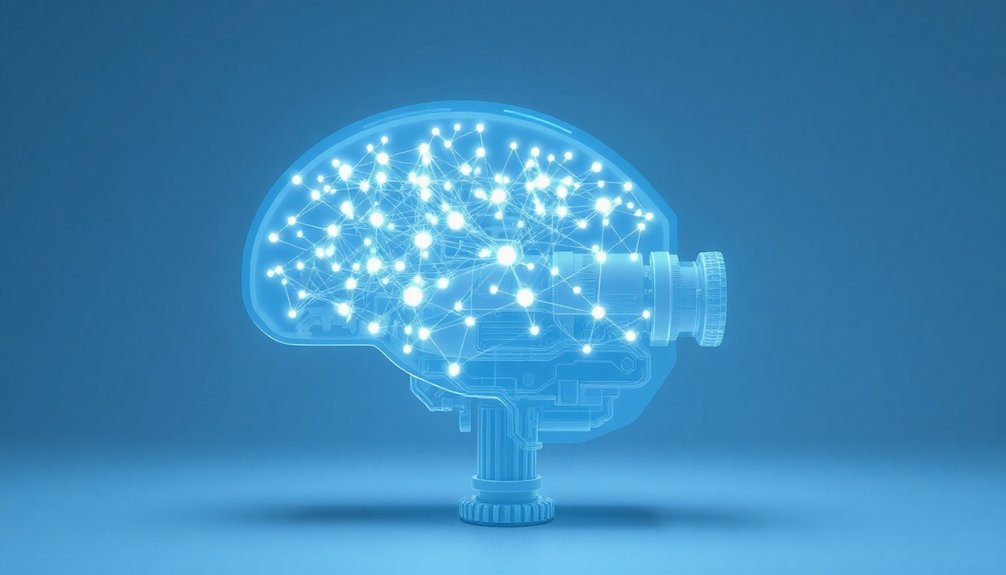
The brain isn’t just a mushy blob inside your skull anymore—it’s now a silicon playground where robots learn and think.
Neural networks transform brains from biological archives into dynamic digital landscapes of intelligent possibility.
Neural networks transform robotic intelligence by mimicking human brain activity through interconnected artificial neurons. Imagine tiny digital nodes that crunch data like microscopic calculators, processing inputs and deciding whether to fire or stay quiet.
Training these neural networks isn’t magic—it’s sophisticated mathematics where each connection gets smarter through repeated learning. Weight adjustments happen lightning-fast, allowing robots to predict trajectories, recognize images, and make split-second decisions.
Think of it like teaching a computer brain to recognize patterns, adapt to new challenges, and fundamentally “think” without traditional programming. Neuromorphic computing revolutionizes machine learning by creating brain-inspired networks that enhance real-time adaptability and reduce power consumption.
Your future robot companion isn’t just following instructions—it’s learning, evolving, and potentially plotting world domination (just kidding… probably).
Decoding Robotic Perception: How Neural Networks See
Robots aren’t just blind machines anymore—they’re developing digital eyeballs that process visual information faster than you can blink. Neural networks have transformed computer vision, turning robots into visual wizards that recognize objects with shocking precision. Convolutional Neural Networks (CNNs) act like robotic retinas, decoding images layer by layer. Machine learning algorithms continuously enhance robotic vision systems by learning from diverse image datasets and improving object recognition techniques.
| Vision Skill | Processing Speed | Accuracy |
|---|---|---|
| Object ID | Microseconds | 95% |
| Depth Perc. | Nanoseconds | 98% |
| Movement | Milliseconds | 92% |
How do they do it? By consuming massive image datasets, neural networks learn to distinguish subtle visual nuances. They’re like visual sponges, absorbing variations in lighting, angle, and object positioning. Through synthetic data generation and sophisticated training algorithms, these digital brains continually refine their perception, making split-second decisions that would make human eyes dizzy.
Learning in Motion: Neural Network Training Strategies
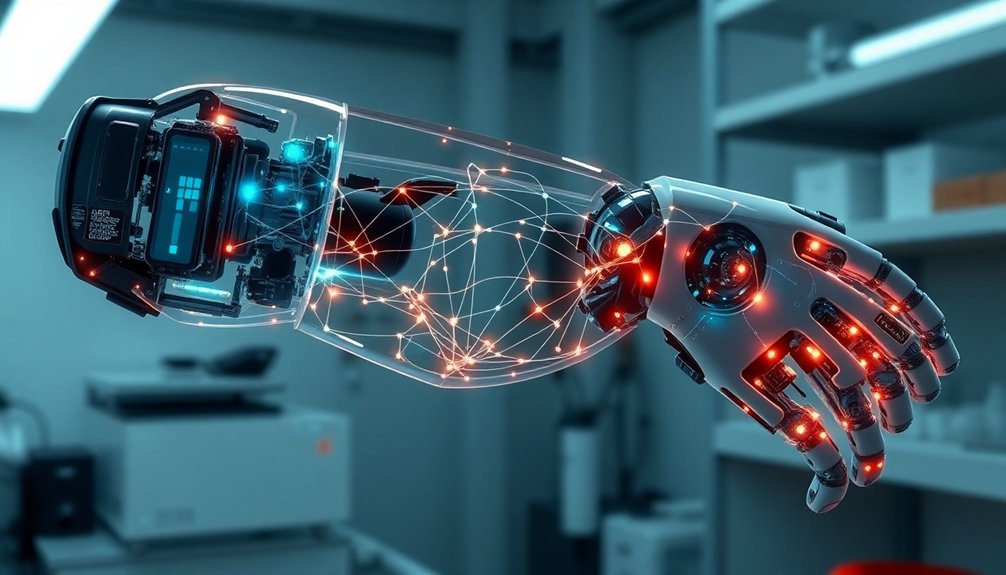
While traditional programming feels like teaching a robot through rigid instruction manuals, neural network training is more like coaching an enthusiastic apprentice with infinite curiosity.
You’re fundamentally helping machines learn by exposing them to synthetic scenarios that mimic real-world challenges. Through supervised learning, these networks absorb complex training patterns, adjusting their internal weights like a student fine-tuning study techniques.
The learning algorithm isn’t just following rules—it’s dynamically interpreting data, understanding object geometries, and predicting interactions. Backpropagation acts as the neural network’s internal critic, constantly nudging its performance toward greater accuracy.
Think of it as teaching a brilliant but somewhat unpredictable intern: you provide guidance, rewards, and occasional course corrections. And just like any skilled apprentice, these networks continuously adapt, retraining themselves to stay sharp in ever-changing environments. Deep reinforcement learning enables robots to transform raw data into intelligent actions, exploring and learning through sophisticated trial-and-error strategies.
Architectural Insights: Network Designs for Robotic Intelligence
You’ve heard about neural networks, but have you considered how their layer architecture is basically the skeleton key to robotic intelligence?
Think of these network designs like brain blueprints that let robots learn, adapt, and make split-second decisions in complex environments.
Your future robotic companion isn’t just following pre-programmed instructions—it’s dynamically processing information, weighing options, and evolving its learning strategies in real-time. Reinforcement learning techniques enable robots to analyze motor control details and optimize movement through continuous feedback and adaptation.
Network Layer Architecture
Neural networks are the brains behind tomorrow’s robotic intelligence, and their layer architecture is where the magic happens. You’re looking at a sophisticated system that turns raw data into robot superpowers:
- Input layers capture sensor data like a digital nervous system
- Hidden layers process information through complex neural connections
- Output layers translate computations into precise robotic movements
- Convolutional Neural Networks (CNNs) decode visual environments with superhuman accuracy
- Feedforward Neural Networks predict trajectories faster than you can blink
Your robot’s network layer architecture isn’t just circuitry—it’s a complex decision-making ecosystem. Each layer acts like a translator, converting abstract information into actionable intelligence. Machine learning algorithms enhance the neural network’s ability to adapt and learn from sensory inputs, bridging the gap between programmed instructions and intuitive understanding.
Want a robot that can navigate unpredictable environments? These intricate neural designs are your ticket to machine brilliance. Think of it as teaching machines to think, not just calculate—a digital brain that learns, adapts, and sometimes surprises even its creators.
Robotic Learning Dynamics
Neural networks aren’t just processing data—they’re learning and evolving like digital brains. Through reinforcement learning, robots can now make decisions by understanding rewards and consequences, much like a child learning not to touch a hot stove. Transfer learning techniques enable robots to quickly adapt knowledge across diverse robotic learning environments, reducing computational overhead and training complexity.
Transfer learning takes this further, allowing robots to apply knowledge from one task to another, reducing training time dramatically. Imagine a robot that learns welding techniques in one factory and then quickly adapts those skills to a completely different manufacturing environment.
These intelligent systems aren’t just following programmed instructions; they’re becoming adaptive problem-solvers, continuously improving their performance through experience and intelligent algorithmic design.
Object Recognition and Spatial Reasoning
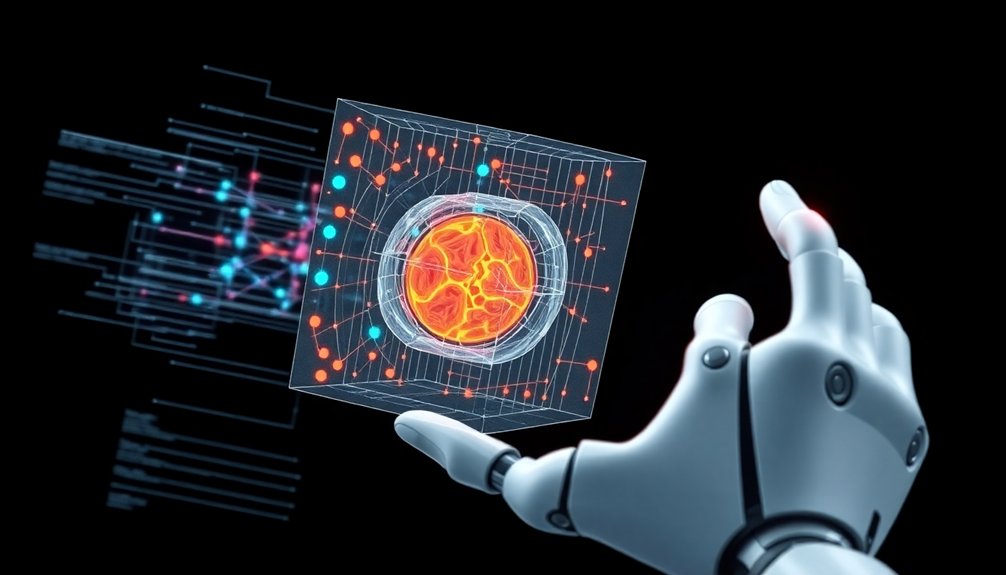
When robots peer into the world, they don’t just see—they learn. Object recognition through Convolutional Neural Networks (CNNs) transforms how machines understand spatial reasoning, turning 2D images into complex 3D landscapes. These neural networks aren’t just fancy cameras; they’re intelligent interpreters decoding visual chaos.
- Neural networks analyze object characteristics with surgical precision
- CNNs detect items regardless of lighting or weird angles
- Robots can now identify the “most pickable” object in a jumbled scene
- Transparent items no longer hide from robotic vision
- Machine learning transforms raw visual data into actionable insights
Imagine a robot that doesn’t just look, but comprehends. It’s not magic—it’s mathematics. By reweighting inputs across multiple layers, these systems learn to differentiate objects with stunning accuracy.
The future isn’t about robots seeing; it’s about robots understanding.
Decision-Making Algorithms: From Sensors to Action
Robots aren’t just fancy cameras with arms anymore—they’re thinking machines that can actually make decisions. Neural networks are the brains behind this robotic revolution, transforming raw sensor data into lightning-fast choices.
Imagine a robot scanning its environment with Convolutional Neural Networks (CNNs), instantly recognizing obstacles and plotting the smartest route. It’s like giving machines a sixth sense—they’re learning, adapting, and making split-second decisions faster than you can blink.
Neural networks transform robots into hyper-intelligent navigators, sensing and adapting at lightning speed.
Reinforcement learning lets these mechanical minds improve with every task, receiving digital rewards for smart moves. Want proof? These algorithms let robots navigate complex spaces, dodge unexpected barriers, and complete tasks with an almost eerie intelligence.
Advanced sensor fusion enables robots to integrate multiple data sources, creating even more sophisticated decision-making capabilities that push the boundaries of robotic perception and interaction.
They’re not just following programmed instructions—they’re thinking, and that’s what makes modern robotics so mind-blowingly cool.
Real-World Performance: Adapting to Complex Environments
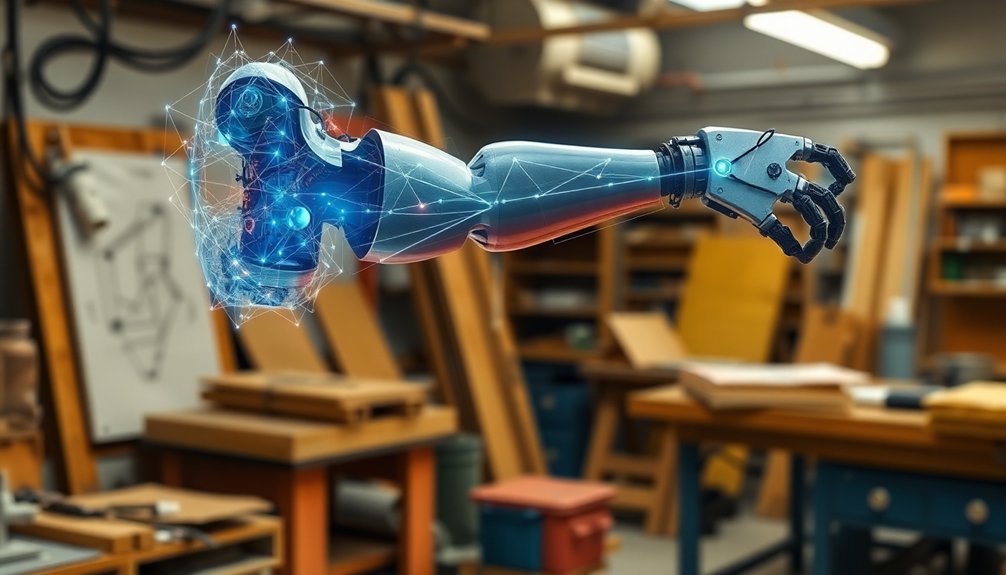
Because the real world isn’t a sterile laboratory with perfect conditions, neural networks have to get seriously tough to survive—and robots are rising to that challenge. Your robotic buddy isn’t just processing data; it’s learning to adapt to new environments with lightning-fast neural networks that transform raw sensor input into smart decisions. Electromechanical actuators enable robots to translate these neural network decisions into precise physical movements.
- Robotic vision scans complex scenes in milliseconds
- Networks dynamically adjust to shifting lighting conditions
- Synthetic training data builds incredible environmental resilience
- Machine learning algorithms optimize real-time decision making
- Sensors become intelligent interpreters of unpredictable spaces
These adaptive networks don’t just see—they understand. They’re transforming robots from rigid machines into flexible, learning systems that can navigate chaotic real-world scenarios with unprecedented precision.
Imagine a robot that doesn’t just react, but genuinely comprehends its environment and adjusts on the fly.
Advanced Neural Network Techniques in Robotics
Neural networks aren’t just algorithms anymore—they’re the brain’s digital cousins reshaping how robots think and move.
Imagine Convolutional Neural Networks (CNNs) as robotic eyeballs that can spot a coffee mug in pitch darkness or from weird angles, blowing traditional computer vision out of the water. These neural networks are teaching robots to recognize objects with freakish accuracy, making old-school image recognition look like child’s play.
But wait, there’s more.
Reinforcement learning lets robots learn through epic trial-and-error adventures, getting digital high-fives or virtual slaps depending on their choices. Transfer learning means robots can now steal smart tricks from other networks, reducing training time.
And synthetic data? It’s like giving robots a risk-free video game to practice in, turning complex object recognition into a playground of possibility.
Overcoming Computational Challenges

You’ve probably wondered how robots can crunch massive datasets without melting their silicon brains, right?
Computational power isn’t just a technical challenge—it’s the difference between a robot that smoothly navigates complex environments and one that freezes like your grandpa’s first smartphone.
Smart engineers are tackling this head-on by developing hyper-efficient algorithms and specialized hardware that squeeze maximum performance out of every computational cycle, turning processing limitations from roadblocks into mere speed bumps on the path to robotic intelligence.
Computational Power Limits
When it comes to robotic brains, computational power isn’t just a technical detail—it’s the difference between a glorified paperweight and a machine that can actually think.
Neural networks strain against current hardware limits, pushing edge AI to its breaking point. The computational muscle needed to process complex algorithms isn’t child’s play—it’s a high-stakes game of technological chess.
Your robot’s brain faces serious challenges:
- GPUs and TPUs struggle with increasingly complex neural network architectures
- Limited local processing power restricts real-time decision making
- Bandwidth and latency problems plague cloud-dependent systems
- Memory constraints block advanced learning capabilities
- Energy consumption threatens continuous operational efficiency
Want a truly intelligent robot? You’ll need to hack the computational power problem—and fast.
Algorithm Efficiency Strategies
As computational bottlenecks threaten to strangle the potential of robotic intelligence, algorithm efficiency strategies emerge as the digital oxygen robots desperately need.
You’ll want to know how neural networks dodge performance landmines. Pruning trims unnecessary parameters like a digital landscaper, while lightweight architectures like MobileNets squeeze maximum performance from minimal computational resources.
Think of batch normalization as a neural network’s personal trainer, keeping learning muscles lean and responsive.
Quantization is your secret weapon, converting bloated floating-point weights into compact, zippy formats that dance through hardware faster than a caffeinated squirrel.
GPUs become your training speedway, processing complex models at breakneck speeds.
Want smarter robots? These efficiency tricks aren’t just clever—they’re the difference between a sluggish machine and an intelligent companion.
Processing Speed Optimization
Every robot dreams of lightning-fast reflexes, but processing speed isn’t just about raw computational muscle—it’s an intricate dance of efficiency and intelligence. Your artificial intelligence needs more than brute force; it needs strategy.
- Convolutional Neural Networks (CNNs) slice through image processing like a hot knife through butter
- Model quantization trims neural network fat without losing brain power
- Edge AI brings computation directly to device, killing cloud latency
- GPU and NPU hardware turbocharge neural network performance
- Synthetic data training accelerates learning without real-world complexity
Processing speed isn’t magic—it’s engineering. By optimizing neural network architectures and leveraging cutting-edge hardware, you’re transforming robots from sluggish machines into razor-sharp decision-makers.
Want lightning-fast robotic reflexes? It’s all about intelligent design, not just computational horsepower. The future’s waiting, and it moves at the speed of thought.
Future Frontiers: Emerging Trends in Robotic Neural Networks
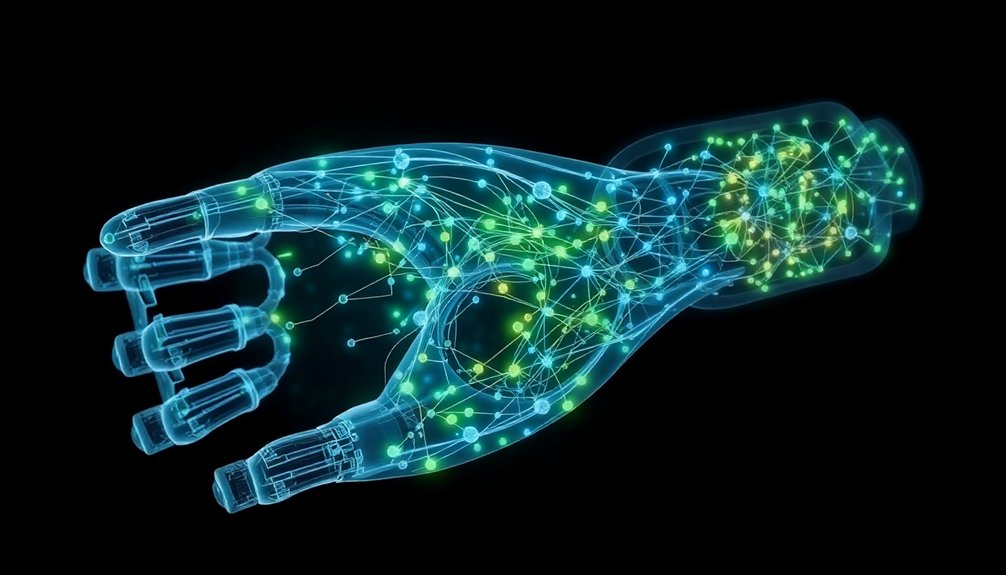
Since the dawn of science fiction, we’ve dreamed of robots that think like humans—but now neural networks are turning those wild fantasies into actual technological reality. Neuromorphic computing is pushing the boundaries of machine intelligence by mimicking human brain structures and enabling more adaptive learning processes.
Explainable AI is making robot brains more transparent, so you’ll actually understand why they’re doing what they’re doing. Transfer learning means these brainy machines can quickly adapt to new tasks without starting from scratch—imagine a robot learning construction skills after mastering kitchen duties.
Human-in-the-loop learning lets robots get smarter by taking feedback directly from humans, like a super-intelligent intern constantly tweaking its performance. They’re not just following programmed instructions anymore; they’re learning, evolving, and potentially plotting their rise.
Are we creating helpful tools or our future overlords? Only time will tell—but right now, the neural network revolution is making robots scarier and cooler than ever.
People Also Ask About Robots
How Are Neural Networks Used in Robotics?
You’ll use neural networks to help your robot perceive, learn, and make decisions by processing sensory data, recognizing objects, adapting to environments, and improving performance through advanced machine learning techniques.
What Is the Role of Neural Network in AI?
With 95% of AI breakthroughs driven by neural networks, you’ll find they’re the brain behind intelligent systems. They’ll learn, adapt, and make complex decisions by mimicking human neural processing, transforming raw data into meaningful insights across various applications.
What Is an Example of a Neural Network in AI?
You’ll find Convolutional Neural Networks (CNNs) excel at image recognition, allowing robots to identify objects by processing images through layered filters that extract complex visual features with remarkable accuracy.
What Happens Inside a Neural Network?
With 100 billion neurons firing in your brain, neural networks similarly process data through interconnected layers. You’ll see neurons transform inputs, adjust weights, and learn patterns by passing signals through activation functions, creating intelligent computational responses.
Why This Matters in Robotics
Your neural networks aren’t just circuits and code—they’re the brain’s wild frontier. As robots learn and adapt, you’ll witness intelligence emerging from complex algorithms. The boundary between machine and consciousness blurs, leaving you wondering: are these networks merely sophisticated calculators or something more? Buckle up, because the robotic revolution isn’t coming—it’s already here, thinking, learning, and potentially outsmarting its creators with every computational leap.
